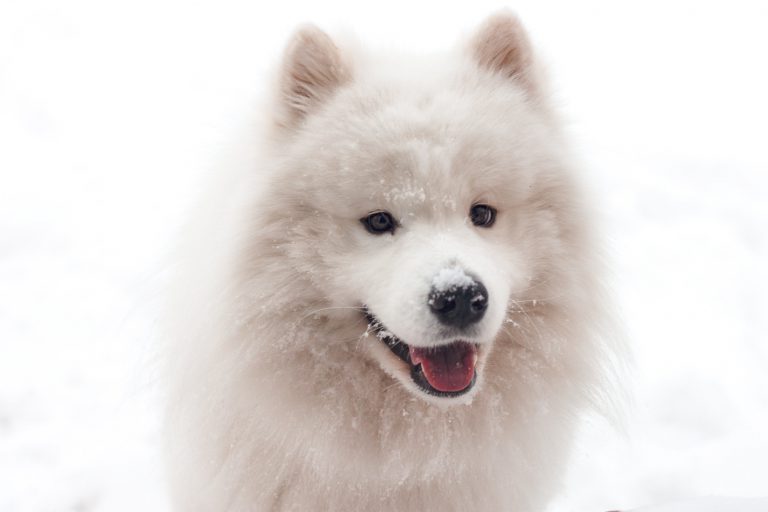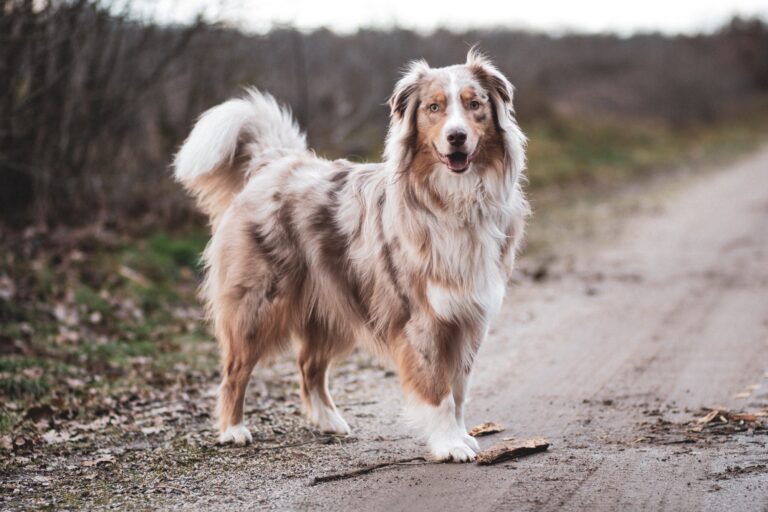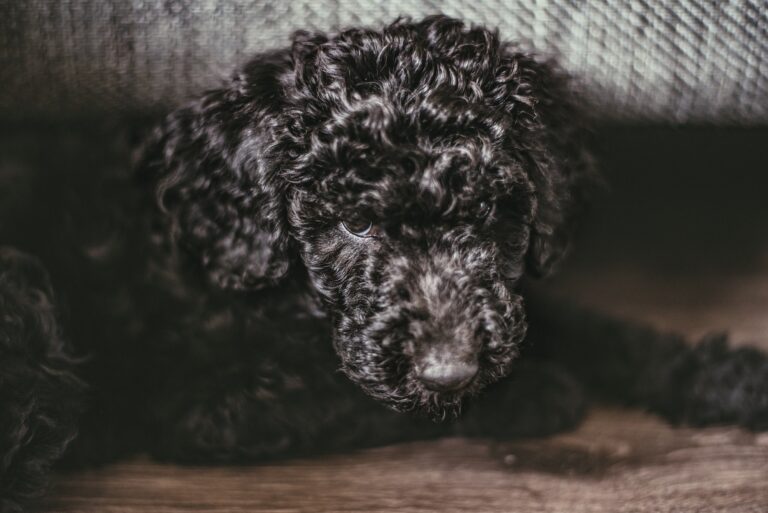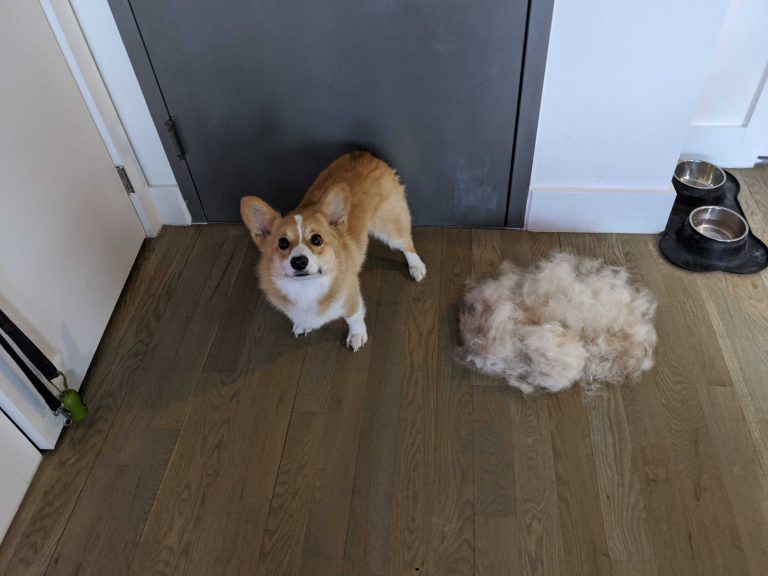A dog’s coat is their most distinguishing feature, and their most magnetic.
Whether silky smooth, curly, or scruffy, a canine coat does more than look good. It keeps a dog warm in winter and cool in summer. It can repel things, like dirt and moisture, while also attracting things, like humans (with its pettable softness) and other dogs (as it transfers chemicals from the skin into the air). A dog’s coat is also a meaningful indicator of overall health.
“Your dog’s coat’s primary function is to protect their skin from the sun, keep them warm or cool, and to keep dirt and water away,” says Dr. Sara Ochoa, co-founder of How-To Pets. It sounds simple, but dog hair is actually beautifully complex. It comes in a stunning array of colors, patterns, lengths and textures that tell a genetic story about your dog, and works in a number of amazing ways to safeguard your dog’s health and comfort.
All that magnificence deserves some care and attention, so we’ll explore some of the things your dog’s coat is telling you, and how to care for it.
But first, let’s give dog fur the credit it deserves.
What is the makeup of a dog’s coat?
Let’s dispense with the label question: is it hair, or fur? Why do we think of ourselves as having hair and dogs and other animals as bearing fur? One popular way of explaining it is that mammals like dogs and bears just have MORE hair, making it fur. But humans actually have the same or similar follicle densities as apes and some other mammals.
There’s also a popular perception that some dogs have hair and others have fur. The truth is that there isn’t any real distinction between hair and fur. They are both (along with feathers, and hooves, and nails) made of the same thing—keratin. Hair is specifically made up of dead cells that have become keratinized, or filled with keratin. Each hair is made up of three layers—the medulla, the cortex, which contains the pigment that gives the hair its color, and the cuticle.
At the root of the confusion about dogs hair vs fur, is the type of hair the dog has.
Most dog breeds have three different types of hair on their bodies: guard hair (aka primary hair, or topcoat), undercoat (secondary hair), and whiskers (which have special powers).
The undercoat is the part of a dog’s coat that grows closest to their skin. It’s got a softer, downy texture suitable to its primary function—providing insulation. The last time you brushed your dog’s hair, you may have noticed a bunch of shorter pieces of hair come out in clusters. These hairs are likely the undercoat. “The undercoat actually helps keep your dog warm in the winter but cool in the summer. Many people will want to shave a husky or other thick-coated dogs in the summertime, but are advised against it, as the undercoat actually keeps them cool,” Dr. Ochoa says.

Double-coated breeds, like German shepherds, huskies, Bernese mountain dogs, collies, corgis, and many others, have an undercoat. Dogs without that undercoat, or single-coat dogs, are the ones known as having hair coats. These breeds, which include the Afghan hound, the poodle, Maltese, whippet, some chihuahuas, and others, have a longer cycle of hair growth which makes it seem as if they do not shed, or shed lightly. In contrast, most double-coated breeds leave a bit more hair around the house, and some “blow,” or shed their entire undercoat, seasonally.
Guard hair is thicker and grows longer than the undercoat. Essentially, when you look at your dog, most of the hair that you see right away is their guard hair.
Guard hair is important because it protects the rest of your pup’s skin from foreign objects; it also serves as an extra layer of protection against cold weather, and injuries. “The topcoat is used to repel water and keep dirt from reaching the skin,” Dr. Ochoa says.
From those basic components come the endless variety of coats we see among different types of dogs.
The wonder of whiskers
And then there are whiskers, the long, coarse hairs that serve the critical function of helping a dog sense the space, and the world, around them. Whiskers, or vibrissae, grow near the dog’s eyelids and muzzle from deep-rooted follicles that are full of nerve endings. These nerves send important messages to the dog’s brain, which is why you may notice a dog reacting immediately to whatever touches their whiskers. Whiskers on the dog’s muzzle typically grow to a length equal to the width of the dog’s head or body, which helps with spatial awareness. These amazing hairs can detect changes in air currents, which help dogs, who are naturally far-sighted, “see” objects that are nearby, and move around in the dark.
Whiskers are an important part of your dog’s sensory toolset which means you should avoid cutting or removing them during grooming.
What determines a dog’s coat coloring?
Located within the hair follicle (the bulb and outer root sheath) are the same skin cells (melanocytes) that make melanin. So just as a human’s eye color, skin tone, and hair color are determined by genetics, a dog’s coat is also determined by their genes.
Amazingly, given the variety of color seen across all types of dogs, only two basic pigments determine coat color: eumelanin ((black, brown, blue, or grey) and phaeomelanin (red, tan, yellow, and cream). Several genes impact coat color by manipulating these two pigments.
In addition to a range of colors, genes can dictate coat patterns including spotted, brindle, dappled, merle and agouti (where each hair shaft has several bands of color).

What does a dog’s coat say about their health?
A dog’s coat can give clues about their health in two main ways. The dog’s coat color or pattern could tell you that the dog may be predisposed to certain genetic disorders. The merle gene, for example, which produces a merle coat, is linked to deafness and vision issues; white color pigmentation (such as in boxers and Dalmatians) is also linked to deafness.
A dog’s coat can also exhibit specific symptoms, such as patchiness, oiliness, balding, itching or thinning, that signify health issues.
To determine what your dog’s coat might be telling you, it’s important to know what their coat should look like. If your dog has a healthy coat and a generally good bill of health, their coat will be soft to the touch and generally feel smooth, even on wire-haired breeds (it should be easy to spot the difference between wiry and brittle). It should look a little shiny.
What your dog’s coat shouldn’t look like: it shouldn’t be excessively oily, have a strong, foul smell (this is an indicator of bacteria or yeast build-up), and it should not appear greasy, dusty, dry, balding, or loose (meaning big chunks of undercoat hair coming out on their own).
An irritated, abnormal coat could imply allergies, hormone problems including thyroid or elevated cortisol, secondary infections, a genetic problem, or other issues. If issues with your dog’s coat persist after addressing diet, consult your veterinarian.
Coat-related symptoms to look out for
Dry, itchy skin
If your dog has dry or itchy skin, it could mean they have allergies. Dogs can have a reaction to any of the typical allergens that people can be allergic to, including pollen from plants and grass, as well as certain foods. The three most common types of allergies seen in dogs include environmental allergies (atopy), brought on by a variety of substances including grasses, pollens, and dust; flea allergies; and food allergies.
Read more about allergies here.
“The most common symptoms seen with dogs with allergies are itching, bald spots, smelly skin, greasy skin, and flaky skin,” Dr. Ochoa says. “Just like with people, when these allergens contact [dogs’] skin, they will start to scratch. This disrupts the normal barrier that is present on your dog’s skin. Your dog’s skin always has bacteria and yeast on it, looking for a place to get into the skin. These micro-abrasions that your dog makes when they are scratching make the perfect place for your dog to develop a skin infection from their allergies.”
If your dog is suffering from dry or itchy skin from allergies, work with your veterinarian on diagnosing the cause. If environmental allergies are suspected, they may suggest intradermal testing with a veterinary dermatologist. If food is the source, they may suggest an elimination diet.
Most dogs with allergies benefit from a bath at least every two weeks, some weekly, and some more often if there is secondary infection present. Consult your veterinarian on the best bathing strategy for your dog.
If your dog is itching frequently, but does not seem to have an allergy, they might have fleas. Flea allergy is the most common allergy seen affecting dogs and cats, more common than pollen or food allergies.“The most common signs that your pet has fleas is actually seeing fleas,” Dr. Ochoa says. “If your dog has very thick hair, however, you may not see them. Your dog may be itching a lot, usually at the base of the tail. They may also be losing hair on their backs.”
Fleas are a pretty common issue with dogs’ coats, so there is minimal need to worry. If you see fleas on your pet, contact your veterinarian to discuss appropriate and effective flea control measures. While treating your pet, remember that fleas also live in your pet’s environment, so make sure to clean anything that your pet sleeps on or an area they spend a lot of time in.
Aside from fleas and allergies, Dr. Ochoa advises that pet owners also be wary of skin mites, which is another common coat health condition. Your dog might be struggling with mites—which may live in hair follicles or burrow into the top layer of the skin—if they are exhibiting signs of intense itchiness (scratching, biting, licking), scaly, crusty skin, redness, sores, white flakes, foul odor, hair loss, and/or lesions on her elbows and ankles. The parasitic mite, Demodex canis, that lives in the hair follicles of dogs can cause Demodectic mange in dogs who have immature or compromised immune systems (typically puppies, older dogs, or dogs who have a serious illness). If you’re seeing any symptoms of mites, be sure to consult your veterinarian.
Itching and hair loss can also indicate a hot spot. Hot spots, or acute moist dermatitis, are areas of infected, inflamed skin that can grow worse with constant itching or licking. They can be caused by insect bites, allergies, and a range of other factors. Dogs with matted or thick coats can be more prone to hot spots and they occur more commonly in warmer weather.
Dullness, dryness, dandruff
This might be harder to spot than itching, but look out for fur that simply doesn’t look shiny and healthy, whether it’s dull, dry and broken, or if your pup has excessive white flakes.
Dull, dry hair can have a wide range of causes. One common culprit is low-quality dog food. Dry, processed food can be poorly digested by your dog, so important nutrients aren’t being absorbed and used by their body. Imbalanced home-cooked meals can also show up in a compromised coat. Health conditions like thyroid disorders and diabetes can also manifest in dry, brittle, or thinning hair.
The issue could also be surface-level: make sure you’re not over-bathing your dog, or using harsh shampoos that aren’t formulated specifically for canine skin and hair. You might also want to skip the blow dryer.
Dandruff in dogs is most commonly a secondary condition and can be related to a whole host of underlying conditions and caused by a range of factors. Dandruff is often related to allergies, but the flakes could also be triggered by thyroid issues, skin infections, diet, or even the weather and humidity levels.
Thinning hair
If your dog’s hair is thinning all over it could indicate an underactive thyroid gland, which can be more common in some breeds, including golden retrievers, Dobermans, and Irish setters. This condition may also come with weight gain and scaly skin.
Illness or stress, can also show up in your dog’s coat, in the form of dullness, brittleness, and excessive shedding.
Hormonal imbalances like Cushing’s disease can also cause thinning or loss of hair. This condition is due to overactive adrenal glands leading to excessive cortisol and is often accompanied by increased urination and drinking and increased appetite.
And just like humans, dogs can get pattern baldness. In dogs, this is often seen as hair loss behind the ears on the backs of the thighs or on the chest and abdomen. Unlike in people, where pattern baldness affects mostly men, pattern baldness in dogs can affect both males and females.
How does nutrition affect a dog’s coat?
The short answer is: nutrition has a huge impact on the health and appearance of your dog’s skin and coat.
“Dry skin and hair coat can be due to a nutritional issue, allergies, or a medical condition,” explains Dr. Gary Richter, DVM. “Conversion to a fresh, whole food diet frequently improves skin and hair coat.” When a dog’s diet is missing something important–like protein, fats, moisture, and sufficient nutrients in the right balance–it manifests in a variety of ways, from dry skin and a dull coat to patches of hair loss.
Read about how fresh food helped Legend Chubbs regain his hair.
Healthy fats are another ingredient for overall health, and skin and coat health. Omega-3s help to reduce inflammation, while Omega-6s increase inflammation, which plays a role in immunity, and cell growth. A healthy balance of these two essential fatty acids provides a range of health benefits including a lustrous coat.
If you’re feeding kibble, which tends to be higher in Omega-6 acids, your dog might have an imbalance which can contribute to chronic inflammation.
If you’re feeding a fresh diet, you shouldn’t need to add extra supplements to achieve a shiny, healthy coat. However, if you want a boost of healthy fats for coat, and overall health, whole sardines are a great source, and a great snack, in moderation.
Dr. Richter says while inadequate hydration and nutrition are usually the issue when it comes to coat issues, if your dog is displaying additional symptoms, it’s worth a trip to the vet.
“If [your dog] is not feeling well, is excessively itchy, or if fish oil didn’t work, consult with your veterinarian about the next steps,” he says.
Grooming a dog’s coat
Nutrition can either positively or negatively affect a dog’s coat, as can external sources such as mites, fleas, and allergies, but grooming is an essential part of taking appropriate care of your dog’s coat.
Bathing your dog
Whether or not they have allergies, correct bathing is actually crucial to maintaining the health of your dog’s coat.
The first step in bathing your dog is taking whatever steps necessary to ensure they don’t despise the whole experience! If you have access to a DIY facility that has elevated tubs, that can be a good option, especially for a big dog. If you’re using your own tub, place a towel in it to reduce the scary slippery feeling and start by just putting your dog in the tub and giving a treat or toy to form a positive association. As you start bathing, make sure that bath time is always associated with good things—if possible, have two people in the room so one can dispense pets and treats while the other does the washing.
Many veterinarians recommend placing cotton balls in your dog’s ears, if they’ll allow it, to prevent water from getting in, which can contribute to secondary ear infections. If you don’t have a hose attachment, have a container on hand to use for rinsing. Use warm water and get your dog thoroughly soaked before applying a gentle, natural shampoo made for dogs. “Human shampoo is at the wrong pH for dogs or cats,” explains Matt Clayton, founder and chief editor at PetHairPatrol.com. Consult with your vet and use a veterinary-recommended shampoo.
Wash every part, from the neck down. Instead of lathering up the face, which your dog may find unpleasant and risks soap irritating the eyes, use a washcloth to clean this area.
Be sure to rinse thoroughly. If possible, towel dry instead of blow drying. Clayton notes, “even cool blow dryers will dry out your dog’s coat. Toweling down and blotting to absorb the majority of the moisture will be effective enough and your pet will naturally take care of the rest. If you get your pet groomed, kindly request that the groomer turn down the blow dryer to the lowest setting or not use one at all.”
There’s no hard and fast rule about how often to bathe your dog—it can depend on breed, lifestyle, and other factors—but you can aim for once a month, or even less often, unless they’re especially dirty or exposed to other irritants. Too-frequent bathing can dry the skin and coat.
Brushing your dog
Brushing your dog keeps them looking great, but also serves some other important functions.
Regular brushing helps to distribute the coat’s natural oils, keeping your dog’s coat shiny. If your dog has an undercoat, regular brushing can help keep them cooler—it prevents this downy hair from getting impacted against the skin to promote the flow of air. This up-close experience can also help you spot anything unusual on or about your dog’s skin, like lumps, or parasites.
Brushing also prevents matting, which isn’t just an aesthetic issue. “If your pet’s hair gets tangled and matted, this can pull on the skin, causing pain and inflammation,” Dr. Ochoa explains. “Also, these mats can also trap bacteria and dirt and debris on the skin. This can damage your dog’s skin and cause it to become infected.” It may also cause a foul-smelling odor, as bacteria build-up has a distinct and unpleasant scent.
Brushing is great for you, too. It builds the bond between you and your dog, and the more you brush, the less hair will land in all corners of your house. “You should brush your dog more often in the spring,” Dr. Ochoa advises. “This is the time of year that most dogs will shed a little more as they are getting rid of their winter coat.”
Brush your dog a few times a week, or even every day during the shedding season to minimize loose dog hair around your house, Clayton explains. “Use a brush that is suitable for your dog’s coat, or if your dog doesn’t like to be brushed, you could try a grooming glove to keep him comfortable. Not only will your dog stay mat-free and healthy, but you will also have a cleaner home, and it will give you and your dog some bonding time.”
Especially if your dog has an undercoat, you will want to invest in two different kinds of dog coat brushes. The first should be your typical, short-toothed brush with widely spaced bristles. This is for general grooming of the topcoat or primary coat. The second tool for coat grooming maintenance is an undercoat rake, which literally looks like a rake (just with a shorter handle).
For “hair coat” breeds, like poodles, and Yorkshire terriers, you can use a comb, or a slicker brush.
You may also want to get a third brush—a finer-spaced brush that can be used around critical areas like your dog’s muzzle, ears, and face.
And now a word from a dog groomer
There’s one thing that Melina Metalios, a groomer at Camp Canine in New York wants dog owners to know about keeping coats in their best shape: “water is the enemy.”
“What I tell clients all the time is if they want to bathe their dog at home, before they put their dog in the tub they should always brush and comb out the dog beforehand.” Basically it’s the same theory as getting a shoelace wet, she says. “When that happens, the knot tightens and is harder to untangle. So before you bathe your dog, brush out and comb them to get all tangles and mats out so they don’t tighten up in the water.” And brushing means brushing all the hair, not just the surface. “What I tell clients all the time who claim that they’ve ‘brushed out’ their dog is that brushing is deceiving,” she says. “They may have only brushed over the top of the coat, and the knots tend to be underneath the top coat closer to the skin. So first, I suggest they brush (I like slicker brushes, they work for all coats) over the top to open the coat a bit. Then after they’ve done that, take a comb and go over the brushed coat to catch the tangles that need to be worked out. If the knots are super tight and a brush and comb will not work the mats out, I suggest the Safari De-matting rake which can break up the mats, and then you can brush and comb over the coat for a smooth finish.”
She also recommends that if your dog has been stuck in the rain or snow and gets wet, brush and comb them out when you get home so the coat dries smoothly and no knots develop.
“It’s important that you maintain your dog’s coat in between grooming sessions if you’d like your dog fluffy and full because we as groomers can only do so much—we are beauticians, not magicians!”
What to do with dog hair?
If you’re brushing your dog the recommended number of times a week, or especially if you’re in the thick of shedding season, you may have quipped to yourself: I could make another dog with all this hair!
While science hasn’t enabled that feat as yet, dog hair is a surprisingly useful substance.
First, dog hair can be composted. Because it is a natural element, it breaks down organically when in the right environment. To get rid of your dog’s expelled undercoat or topcoat, you can simply add it to your compost.
Don’t have a compost? You can technically just leave it outside in the grass or dirt (not on the streets if you live in a city). Animals like birds, squirrels, and mice will use the hair to make nests for themselves outdoors. Better dog hair than plastic or other harmful items for their homes, right?
Dog hair can also be planted in your garden or added to the soil of potted plants. Hair (even human hair) is full of nitrogen, which is a necessary element that helps plants perk up and grow tall. It may seem weird to bury your dog’s hair, but your plants will thank you.
So, the next time you find yourself picking out furballs from the carpet or vacuuming the couch for the umpteenth time, remember how amazing your dog’s coat really is. It may seem like a pain when it’s shedding all over the rug and furniture, but a dog’s coat is a critical part of their identity and their health, and your dog wouldn’t be your dog without it.
Photos in story: Samoyed photo by Sveta Golovina on Unsplash; Australian shepherd by Maud Slaats on Unsplash; Poodle photo by Sander Weeteling on Unsplash; Corgi by Dillon Jason.











